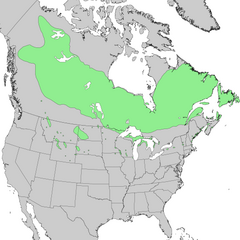Juniperus horizontalis
| Juniperus horizontalis | |
|---|---|

| |
| Foliage and cones | |
| Scientific classification | |
| Kingdom: | |
| Division: | |
| Class: | |
| Order: | |
| Family: | |
| Genus: | |
| Species: | J. horizontalis
|
| Binomial name | |
| Juniperus horizontalis Moench 1794
| |

| |
| Natural range of Juniperus horizontalis | |
| Synonyms[1] | |
Juniperus horizontalis (Creeping Juniper or Creeping cedar[2]) is a low-growing shrubby juniper native to northern North America, throughout most of Canada from Yukon east to Newfoundland, and in the United States in Alaska, and locally from Montana east to Maine, reaching its furthest south in Wyoming and northern Illinois.

It lives up to both its scientific and common names, reaching only 10-30 cm tall but often spreading several metres wide. The shoots are slender, 0.7–1.2 millimetres (0.028–0.047 in) diameter. The leaves are arranged in opposite decussate pairs, or occasionally in whorls of three; the adult leaves are scale-like, 1-2 mm long (to 8 mm on lead shoots) and 1–1.5 millimetres (0.039–0.059 in) broad. The juvenile leaves (on young seedlings only) are needle-like, 5-10 mm long. The cones are berry-like, globose to bilobed, 5–7 millimetres (0.20–0.28 in) in diameter, dark blue with a pale blue-white waxy bloom, and contain two seeds (rarely one or three); they usually have a curved stem and are mature in about 18 months. The male cones are 2–4 millimetres (0.079–0.157 in) long, and shed their pollen in early spring. It is dioecious, producing cones of only one sex on each plant.
It is closely related to Juniperus virginiana, and often hybridizes with it where their ranges meet in southern Canada. Hybrids with Juniperus scopulorum also occur.
Cultivation and uses
Well over 100 different cultivars have been selected for use as ornamental plants in gardens, their strictly prostrate growth habit being valued for ground cover. Popular examples include 'Bar Harbor', 'Blue Acres', 'Emerald Spreader', 'Green Acres', and 'Wiltonii' ("Blue Rug Juniper"). Many of the most popular cultivars have strikingly glaucous foliage, while others are bright green, yellowish or variegated.
References and external links
- ^ Juniperus horizontalis The Plant List (2010). Version 1. Published on the Internet; http://www.theplantlist.org/ 22 Nov. 2011
- ^ Bailey, L.H.; Bailey, E.Z.; the staff of the Liberty Hyde Bailey Hortorium. 1976. Hortus third: A concise dictionary of plants cultivated in the United States and Canada. Macmillan, New York.
- Template:IUCN2006
- Adams, R. P. (2004). Junipers of the World: The genus Juniperus. Trafford Publishing ISBN 1-4120-4250-X
- Gymnosperm Database: Juniperus horizontalis
- Flora of North America: Juniperus horizontalis
-
Juniperus horizontalis 'Wiltonii' as a garden plant



